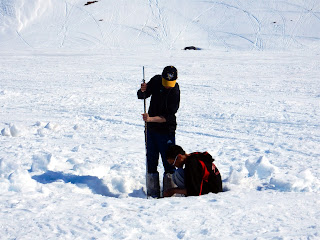Warning: This post contains pictures & descriptions that some readers may find graphic.
Everyone was out and about at 11am. The date was May 27. The weather had greatly improved over the last 9 hours. The overcast clouds were gone, replaced by blue skies, and a very bright sun. I left my thick Canada Goose parka inside my tent because it was just too warm to wear. The turtleneck and t-shirt I was wearing on my torso would suffice. However, I kept my snow pants and thick Baffin Impact boots on. A small flock of seagulls stood in the centre of the frozen lake, waiting for people to discard food, and/or pull up fish from several ice fishing holes.
 |
| Cadets & CI Reid eating breakfast. |
 |
| Male cadets on a hill. |
 |
| Me waiting for the cadets to come down the hill. |
 |
| Ranger Samson feeding the nets into the hole. |
Laying fish nets is more complicated. First an ice hole is drilled and a long wooden plank is fed into the hole. There may be a specific name for this plank but I do not know it. A rope is tied to the plank so that it’s not lost underneath the ice. The water carries the plank for several metres. A second hole is drilled above the plank and fished out using an ice chisel. With the plank and rope now running underneath the ice, you can attach your nets to the rope and pull them until they stretch from both holes.
Everyone sat under the warm Arctic sun and jigged for fish. Some people caught very small char but I didn’t catch anything. Even though the char underneath me evaded my lures, it felt nice to just sit outside and not have to think about the outside world. We jigged for about an hour.
 |
| Ice patches. |
 |
| Camp site. |
 |
| Me cutting raw pieces of char. |
 |
| Me eating Arctic char. |
 |
| Maybe I had too much char. |
 |
| Ranger Samson's son posing with the seal he caught. |
 |
| Ranger Samson cleaning arctic char. |
 |
| Cadet Tilley, C. cleans an arctic char. |
 |
| Ranger Samson and two cadets cut pieces of seal. |
 |
| Helping ourselves to seal meat. |
 |
| Senior cadet Natanine enjoys a seal eye. |
 |
| Me & Ranger Samson looking at the seal brains I'm about to consume. |
“You’ve done something I can’t do,” remarked Ranger Samson. “I can’t eat seal brains.”
“It’s an acquired taste,” I replied. I washed down the taste with juice.
 |
| Seal meat in a pot. |
We didn’t bring any wood for a bonfire so I gave the cadets free time until bedtime. They jigged for fish and climbed the surrounding mountains. Everyone was sleeping by 11pm.
To Be Continued . . .









No comments:
Post a Comment